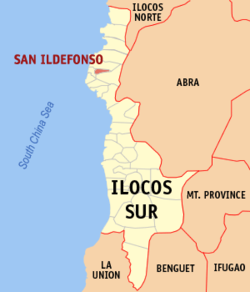San Ildefonso, Ilocos Sur
This article needs additional citations for verification. (September 2013) |
San Ildefonso | |
|---|---|
 Map of Ilocos Sur showing the location of San Ildefonso | |
| Country | Philippines |
| Region | Ilocos (Region I) |
| Province | Ilocos Sur |
| District | 1st District |
| Founded | March 1625 |
| Barangays | 15 |
| Government | |
| • Mayor | Mark A. Purisima |
| Area | |
| • Total | 11.35 km2 (4.38 sq mi) |
| Population (2010)[3] | |
| • Total | 7,075 |
| • Density | 620/km2 (1,600/sq mi) |
| Time zone | UTC+8 (PST) |
| ZIP code | 2728 |
| Dialing code | 77 |
| Income class | 5th class |
San Ildefonso is a fifth class municipality in the province of Ilocos Sur, Philippines. According to the 2010 census, it has a population of 7,075 people.
The town is rich in rice, corn, sugarcane, malunggay, katuday & fruit-bearing trees such as star apple, chico, mango, camachile & atis. Its main product is basi, a wine made from fermented sugarcane juice; as well as cane vinegar. They also make nutritious ice cream made up of vegetables in Barangay Bungro, and is being popularized by the town's local government.
Geography
San Ildefonso is located south of Santo Domingo, west of Bantay, east of San Vicente & Sto. Domingo and north of Bantay.
Barangays
San Ildefonso is politically subdivided into 15 barangays.
- Arnap
- Bahet
- Belen
- Bungro
- Busiing Sur
- Busiing Norte
- Dongalo
- Gongogong
- Iboy
- Kinamantirisan
- Otol-Patac
- Poblacion East
- Poblacion West
- Sagneb
- Sagsagat
Etymology
San Ildefonso, like many other places in the provinces at the beginning of the Spanish Regime, did not have a name. Sometime in 1625, its inhabitants decided to give it a name, but nothing came out after more than five hours of discussions. So while thinking of a name, they decided to go fishing for a week. And while preparing to go fishing, they saw a box floating not far from shore. Wading to reach the box and carrying it ashore, they opened the box to find a statue of Saint Ildephonsus. The young women of the place carried the statue to the center of the village, where it was enshrined in a small hut for many years. He became the patron saint of the municipality, and his name was decided to become the name of the fledgling municipality.
San Ildefonso was a former rancheria of Bantay before it became a municipality, but because of its size it was annexed to Santo Domingo as a barrio. In 1921, Assemblyman (and future Philippine president) Elpidio Quirino worked to convert San Ildefonso into a municipality again.
Demographics
| Year | Pop. | ±% p.a. |
|---|---|---|
| 1990 | 4,528 | — |
| 1995 | 5,232 | +2.74% |
| 2000 | 5,584 | +1.41% |
| 2007 | 6,670 | +2.48% |
| 2010 | 7,075 | +2.17% |
| Source: National Statistics Office[3][4] | ||
Local government
Municipal Officials Year 2000-2013:
- Mayor: Mark Anthony A. Purisima
- Vice Mayor: Salvador Romano
- Sanguniang Bayan Members:
- Rosario Castillo
- Elmerson Jay-r Riego
- Romeo Palomares
- Pedro Rocod
- Mariano Pamo, Jr.
- Mely Dela Cruz
- Wilfred Pedres
- Quirino Dela Cruz, Jr.
- ABC Pres. hon.Robert Tabucao
- SK Fed. Pres. Mark Janmuel Luczon
Educational institutions
- Belen National High School
- San Ildefonso Central School
- Bungro Elementary School
- Sagsagat Elementary School
- Busiing Community School
- Philippine Science High School [Ilocos Region Campus] (PSHS-IRC)
- Day Care Centers (different barangays)
200th Anniversary of Basi Revolt
On September 28, 2007, San Ildefonso officials (Governor Deogracias Victor Savellano and Rep. Ronald Singson) commemorated the Basi Revolt. Recently, the Sangguniang Bayan of San Ildefonso approved a resolution declaring September 16 as a non-working holiday and named the old road in Barangay Gongogong as Ambaristo street in honor of Pedro Ambaristo, leader of the Basi Revolt. Mayor Christian Purisima enrolled basi as their entry into the “One Town; One Product” (OTOP) program of Governor Savellano.[5]
References
- ^ "Official City/Municipal 2013 Election Results". Intramuros, Manila, Philippines: Commission on Elections (COMELEC). 1 July 2013. Retrieved 24 September 2013.
- ^ "Province: ILOCOS SUR". PSGC Interactive. Makati City, Philippines: National Statistical Coordination Board. Retrieved 24 September 2013.
- ^ a b "Total Population by Province, City, Municipality and Barangay: as of May 1, 2010" (PDF). 2010 Census of Population and Housing. National Statistics Office. Retrieved 24 September 2013.
- ^ "Province of Ilocos Sur". Municipality Population Data. LWUA Research Division. Retrieved 24 September 2013.
- ^ Abs-Cbn Interactive, Ilocanos mark 200 yrs. of Basi Revolt
